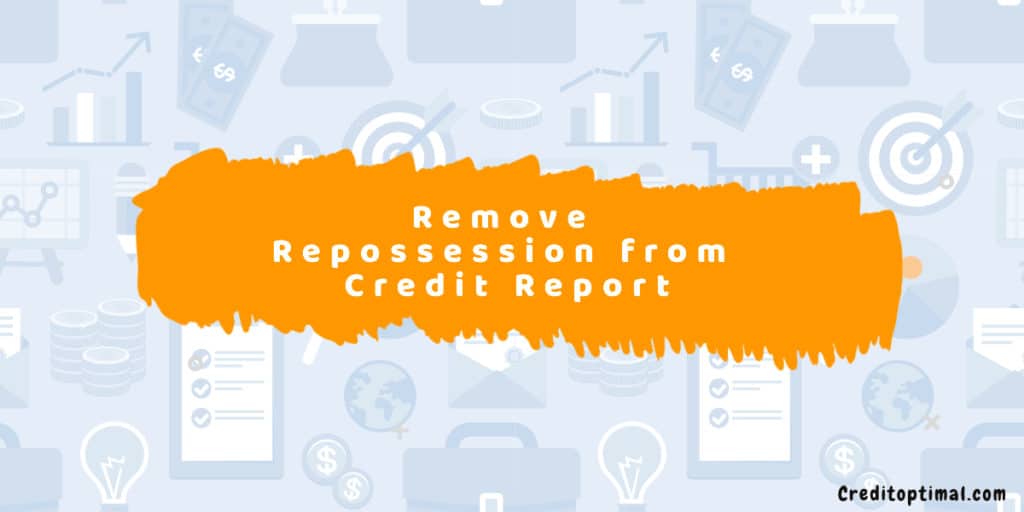Life is full of unprecedented events that might jeopardize your ability to complete payment.
At a glance, a repossession occurs when you take decades to complete your auto loan. This makes the car lender take back the possession of the vehicle.
The repossession usually happens without your consent nor that of a court of law.
If you default on making your auto loan payments, the loan issuer can repossess your car.
This repossession is usually a viable way for the lenders to recover their money through valuing your vehicle and setting it for auction.
When a repossession happens on your credit report, it will not only impact your score but also affect future transactions for close to a decade.
Besides meeting a specific criterion for removing the repossession, you need to watch your different loan payment habits.
What is a repossession?
If you’ve taken out an auto loan and fallen behind for a significant period, the lender will take possession of the car. This usually happens without your permission nor that of court.
Usually, there are lots of paperwork entailing specific terms and conditions.
A voluntary repossession, otherwise known as voluntary surrender, occurs when you turn over the vehicle to the lender when you see that you cannot meet the payment terms.
An involuntary surrender occurs when a credit collection company comes to seize the vehicle on behalf of the lender when you default.
From a loan issuer’s perspective, there is a minimal disparity between a voluntary and involuntary repossession. Simply said, they both cripple your ability to get new loans and tank your credit score.
Yet, with some lenders, a voluntary response might work to your leverage. When you want to borrow money from another lender in the future, a voluntary response will show that you’re more cooperative with the loan terms and conditions.
If you get another loan from the same lender, you might find the interest rates less favorable due to the perceived risk.
The repossession process
Some states have specific terms on how the loan issuer can take your vehicle if you default on the loan payment.
In some states, one delinquent payment is enough to make you lose your vehicle for good.
While every state has its specific laws, the repossession procedure entails the following steps:
- You default on the auto loan and breach the terms of the contract.
- The loan issuer takes the vehicle, either through the voluntary or involuntary process.
- The respective credit bureaus update your credit report and add an entry based on how the repossession occurred.
- Depending on whether you make the payment and your statue of residence, your vehicle is set for auction. At this point, you may pay what you owe and redeem your vehicle.
- If the vehicle is auctioned, the lender clears the balance using the amount obtained from the sale.
- Any remaining balance from the sale could appear in your credit report.
If the deficient balance is significant to make the creditor sue you, you may go through the court process. The court process will proceed as long as your statue limitations haven’t run out.
The impact of repossession on your credit report
A repossession will stay in your credit report for as long as seven years.
The repossession’s impact on your credit score may start dwindling with time. At the same time, you may continue struggling before this time elapses.
Credit scoring models for the three credit bureaus treat repossessions as a significant detrimental element in your credit report.
It’s impossible to determine how much a repossession can impact your credit score. Besides, the damage it does to your credit report will be different from another person’s credit report.
Finance experts estimate that repossession will eat out at least 100 points in your FICO score. After about two weeks, the lender will start calling you to address the issue.
If you stay for a month without paying the balance, you’ll see negative entries on your credit report. The entries are encapsulated as a specific code dictated by the respective credit bureaus.
One notable element about repossessions is that they do not signify the end of the road for your loan payment.
If the loan issuer takes your car, you might have to pay the remaining balance if the vehicle’s value does not meet the loan amount.
Besides, if the bank takes the case to court, you might see a judgment in your credit report.
Cumulatively, these events might affect your credit score and bar you from getting more credit for seven years.
Over the course of this period, the impact of these entries will start dwindling.
If you pay the current balance on time, you might see the score improving in a little over three months.
Thankfully, you can work to remove the negative items if they cripple your ability to get new credit and move forward in your financial life.
Step-by-step Guide – How to Remove a Repossession from Your Credit Report
Get your credit report
You cannot be certain that it’s a repossession eating out the points in your credit score if you don’t check your credit report for negative entries.
Once you get the copy, examine it for any mistakes as you try and identify the areas that need improvement.
A report by the FTC revealed that at least 20% of US citizens have a mistake in their reports. This trend means you cannot overrule this possibility.
Examine reports from the three credit bureaus and check if you have any mistakes. Such inaccuracies include your address, typos and loan amounts.
Negotiate payment terms with the lender
If you can convince the loan issuer that you can make small payments until you complete the loan amount, they might give you a second chance.
Whether it’s a bank, an online financer or an in-house lender, you can propose a deal that you’ll pay off the balance. Follow by requesting them to remove the detrimental elements.
Keep in mind that it’s probable you’ll be communicating with policymakers; hence you should put everything in writing and include all details about the loan amount.
This strategy isn’t going to be straightforward, but if you have the right amount of persistence, it will work to your leverage.
Start a dispute
Disputing with the three data centers will be an incredible shot if you believe the repossession emanated from a mistake.
Data from these three information centers is crucial when lenders want to give you a loan. This means that disputing the negative entries could be the last arrow in your quiver.
That said, check entries such as the dates, balances, account numbers and terms of payments. Afterward, dispute the inaccuracy in case you find the bureau reporting inaccurate information.
The bureau will have 30 days to respond to the negative entry, and if they can’t verify it, they’ll have to delete the entry per the FCRA regulations.
It is possible to delete a negative entry using this approach, but it’s not always a guarantee.
If you fail to get a response from the credit bureaus, reach out to the federal trade commission to follow up on your case.
Consult a credit repair company
If the above steps prove futile, consulting a credit repair company might be a viable option for you.
Credit repair companies might not guarantee results, but their years of experience in working with repossessions might work to your leverage.
Besides removing a repossession, credit repair companies might also review other negative entries. This review will help you rebuild credit.
Credit repair companies need some amount of investment, but one notable perk of going this route is that it will save you lots of time and money.
How to avoid a repossession
The best strategy is avoiding a repossession altogether, rather than waiting for the loan issuer to come for your vehicle.
If you think you might default your loan payments, inform the lender right away and prepare to negotiate with them.
If the lender asks you to consider a voluntary surrender, make sure to confirm the repossession on specific terms. Confirm only if they agree not to report the activity.
Another viable option to avoid losing the vehicle is loan deferment. It works by skipping one or two payments and agree to pay the extra fees and interests. You could also give the deferment and sell your vehicle at the top dollar if you have enough equity in it.
Whichever the method you choose, be careful with your negotiations. Make sure to write everything to get all the repossession out of your credit report without tanking your credit score.
Conclusion
No doubt, no one wants to have their vehicle repossessed. Besides, no one wants to damage their credit score from this repossession.
While there are several ways to delete a repossession, going the way of a credit repair company is the most viable route.
Overall, avoiding repossession is the best way to maintain a hold of your financial life.


